Chairman Green, Ranking Member Thompson, and distinguished members of the committee, thank you for the opportunity to testify.
My name is David Bier. I am the Associate Director of Immigration Studies at the Cato Institute, a nonpartisan public policy research organization here in Washington, D.C. As a policy advisor for a former member of the House, I am honored to be invited to speak with you today about the challenges that America’s outdated immigration system poses for local communities in every state.
My testimony will show that immigrants are not the cause of those challenges. Instead, America’s restrictive immigration system and border crackdowns on asylum seekers are only adding to them. A legal, vetted, and orderly system of legal immigration would restore order and benefit cities and towns across this country.
Restrictive Immigration Policy Burdens American Communities
For more than four decades, the Cato Institute has produced original research on immigration law and border security. This research has shown that a freer, more orderly, and more lawful immigration system would benefit Americans in a multitude of ways, freeing both immigrants and Americans to contribute more to this country, economically and socially. We see people as the ultimate resource: that given the freedom to thrive, people—regardless of birthplace—are a benefit to our society and the world.
Unfortunately, America’s current legal immigration system is highly restricted by every measure—compared to demand, compared to other similarly developed countries, and compared to America’s own history. Outside of the immediate family of U.S. citizens and green card holders, a person’s chances of being able to immigrate legally are extremely low. To briefly review the four available permanent immigration options:
- The capped family-sponsored system is so backlogged that millions of sponsors will be dead before the immigrant receives a green card.1
- Employer-sponsored green cards also have a backlog of over 1 million, and they are virtually impossible to obtain for those without very high wage offers.2
- The world has a refugee population over 20 million, and the United States accepted barely 25,000 through its refugee program last year—0.1 percent.3
- The diversity green card lottery is available to immigrants if they are not from the main origin countries and have a high school degree or experience in a skilled job, but it offers entrants just a 0.2 percent chance of receiving a green card.4
This constrained system is a total rejection of America’s founding traditions. In the late 19th and early 20th century—before Congress closed the doors to legal immigrants—the United States permitted a much higher annual rate of legal permanent immigration, commonly exceeding one percent of its population—over three times the legal rate in recent years and the equivalent of 3.3 million people annually today.5
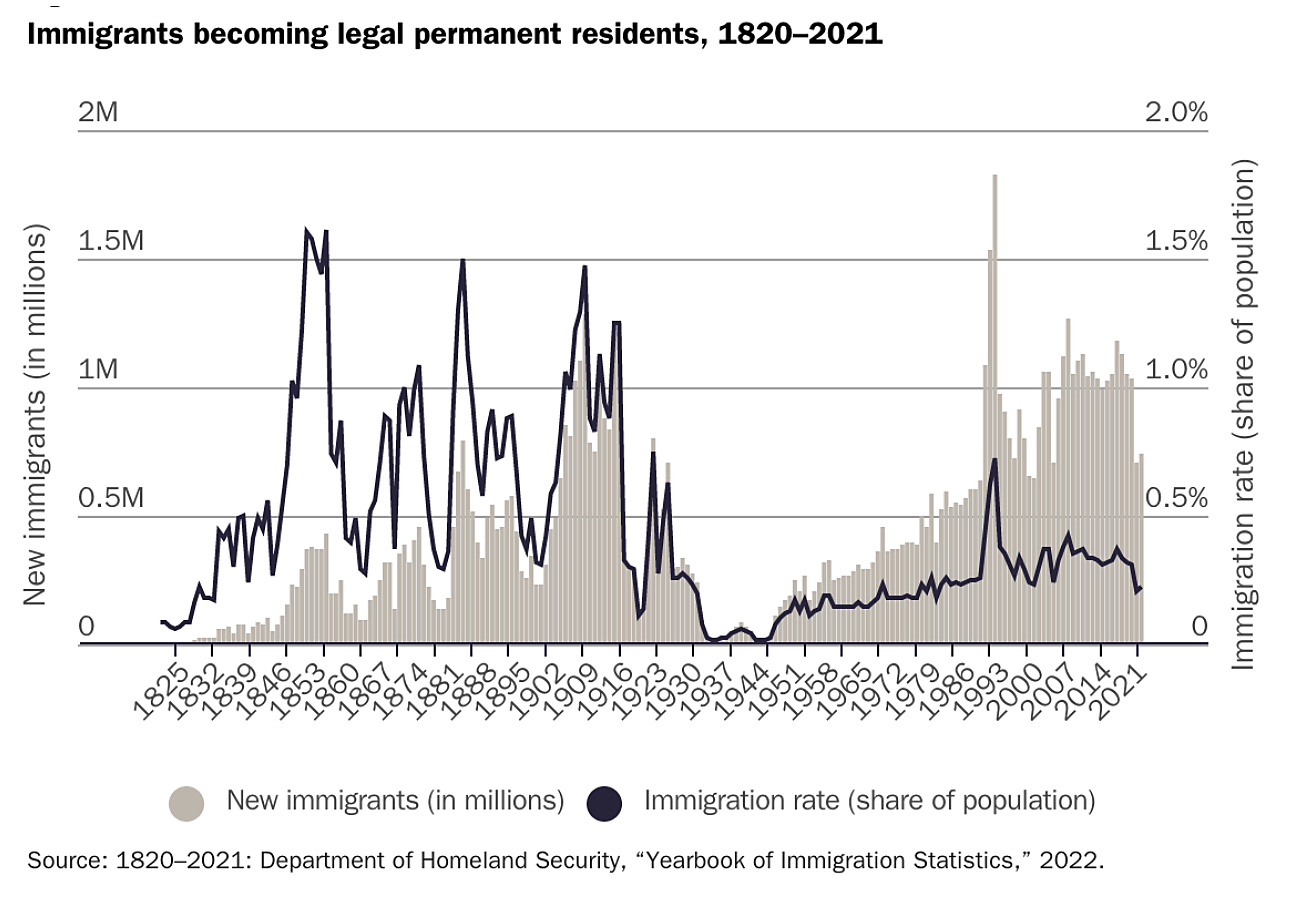
Compared to its peers, the United States ranks in the bottom third of wealthy countries for foreign-born population share.6 Even if tens of millions of immigrants arrived and stayed in the United States over the next decade, Australia, Canada, and New Zealand would still have more immigrants per capita than the United States. It would take 75 million immigrants arriving tomorrow for the United States to overtake Australia.7 In reality, over the last decade, the immigrant share of the U.S. population increased by just over a half of a percentage point, and it did not increase at all from 2017 to 2021.8
As a result, Sweden, Germany, Iceland, Ireland, and Cyprus have all surpassed the U.S. foreign-born share in the last two decades.9 This situation isn’t surprising because Congress has refused to update its legal immigration system for the last 33 years—a time before the World Wide Web.
America’s restrictive immigration policies are harming American communities in every part of the country. The worker shortage—which now numbers over ten million open jobs—has cost the country nearly $1 trillion in lost productivity over just the last year.10 It is undercutting America’s competitive edge in international trade and technological development, sending good-paying jobs for Americans abroad.11 Population decline is eroding tax bases in cities both large and small. Nearly three-quarters of America’s counties had more deaths than births in 2021,12 and U.S. population growth is the lowest that it has ever been in our history.13
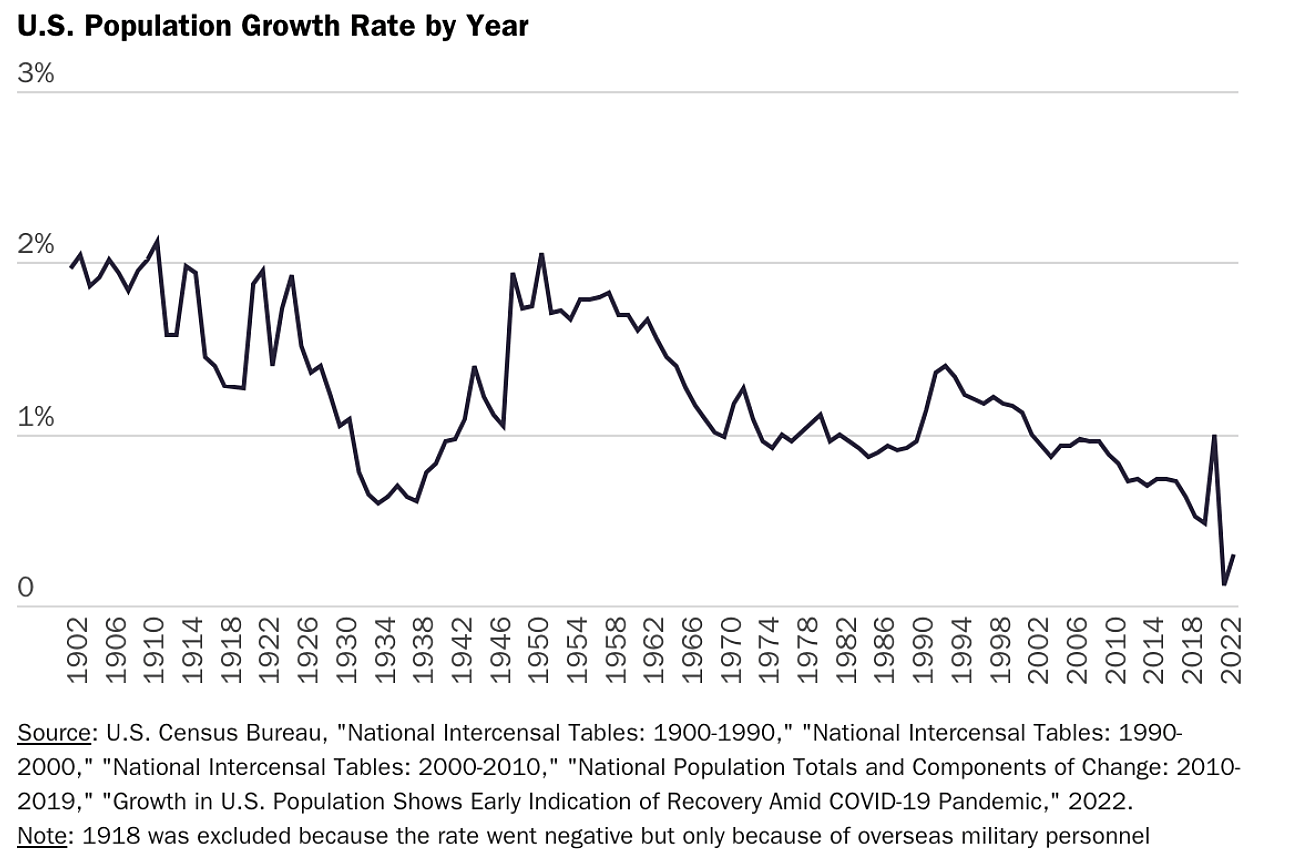
Besides the negative economic effects of population decline, social capital is lost when churches, basketball leagues, book clubs, and community centers lose members and participants, and American families are harmed when they cannot reunite with immigrant family members stuck abroad. Population decline can even increase crime rates.14 Immigrants fill an essential part of the social fabric that makes America strong, healthy, and vibrant. American communities suffer when the U.S. government interferes to force worker shortages, population decline, and family separation.
Another unfortunate side effect of America’s restrictive immigration system is that millions of people who want to contribute their skills and hard work cannot do so legally, which leads to violations of the law. Congress has created a situation where illegal immigration is the only way to enter the country for most immigrants, so it is not surprising that illegal immigration is common.
The lack of legal status for many immigrants fractures communities across the country. Entrepreneurs, small business owners, and farmers see workers that they thought were legally employed ripped away overnight.15 American families are shattered when spouses of U.S. citizens are deported and banned from ever returning to this country. U.S. workers can even see their employers be shut down if the owners are arrested for lacking documents or hiring immigrants without documents. It took years for Postville, Iowa to recover after a massive enforcement raid removed a significant portion of the town.16 Dozens of homes were foreclosed. Restaurants closed. The social disruption lives on.
Laws that were better reflective of the social and economic reality in the United States would reduce violations of the law, allowing the country to benefit from immigration without the downsides and costs associated with illegal immigration.
Immigrants Make American Communities Safer
Immigrants contribute to the safety and security of American communities in numerous ways. First, they directly lower the crime rate by committing fewer crimes. According to data from the Census Bureau’s American Community Survey, immigrants are half as likely to end up in the criminal justice system and behind bars (Graph).17 This is true, even for immigrants in the country illegally, despite thousands of those immigrants being incarcerated solely for immigration offenses that U.S. citizens cannot commit.

The lower crime rates create safer communities for Americans to live. During the 1990s, when the immigrant population grew faster than any time in over a century, crime fell rapidly across the country.18 Immigrant-dense cities saw crime fall further and faster than elsewhere in the country during that time.19
Immigrants also directly affect the crime rate through their participation in or cooperation with law enforcement. There were over 80,000 immigrants serving as detectives and police officers in 2021, and about 350,000 immigrants in protective service roles including corrections officers, bailiffs, private security, firefighters, and other similar positions.20 Training more police officers is a proven way to reduce crime,21 yet many cities are finding it difficult to fill open jobs. In Tulsa, Oklahoma, for instance, there are 160 officer jobs unfilled.22 In 2015, the Nashville Police Chief Steve Anderson convinced legislators in Tennessee to open police recruitment to noncitizens with military service to help address the shortage, and other departments are opening to immigrants as well.23
Even if they don’t or can’t serve directly, immigrants aid law enforcement through cooperation with authorities. Immigrants to New Jersey helped turn around the South Paterson, an area once beset by crime and corruption. The Paterson police commissioner pointed to the willingness of immigrant business owners to work with police as one major reason for its lower crime rate.24
There are countless examples of immigrants helping law enforcement to stop criminals or prevent crimes. Two foreign students stopped a sexual assault at Stanford, testifying against the rapist at trial.25 Another immigrant lost his life stopping a rape in Virginia.26 A video filmed on a Dominican immigrant’s phone was the basis of a homicide conviction in South Carolina.27 A Colombian immigrant in Miami drove his van between an officer and an active shooter, saving the officer’s life.28 A major source of funding for local police comes from the Edward Byrne Memorial Justice Assistance Grant (JAG) Program. Byrne was a New York City officer killed guarding a Guyanese immigrant who had repeatedly reported criminal activity by U.S. citizens in his community.29 The immigrant then again risked his life to testify against Byrne’s killers.
Immigrants without legal status also can help stop crimes. An unauthorized immigrant acting as a convenience store nightwatchman stopped a burglary in Texas.30 Another in New Mexico chased down a child abductor, returning a 6‑year-old girl to her parents.31 It is not even uncommon. About 100,000 immigrants have obtained legal status through their cooperation with law enforcement over the last decade,32 and local agencies have more than 315,000 requests pending for unauthorized immigrants to receive status based on their cooperation with them right now.33
Immigrants also lower crime indirectly. One important mechanism is by economically revitalizing neighborhoods. Based on data from the Census Bureau’s Current Population Survey, immigrants increase state and local tax revenues by over $250 billion per year—52 percent higher than the benefits that they receive and a net fiscal contribution of tens of billions annually.34 Tax revenue from new arrivals allows cities to expand police forces, clean up streets, and make other improvements that lower crime. Research published in the Journal of Criminal Justice has shown that just filling abandoned buildings makes residents less likely to commit crimes.35 Over the last two decades, refugees and asylum seekers went into the lower-cost and higher-crime West Side of Buffalo, for example. They took over vacant lots and businesses, and crime fell there by 70 percent.36
This point is worth reemphasizing: immigrants have just as much of a stake in safe communities as Americans. When immigrants do commit crimes, their victims are usually other immigrants.37 If we want to root out the bad apples, we should want to create policies that make it easier for immigrants to cooperate with law enforcement. That means providing a path to citizenship for law-abiding immigrants, and assuring that future immigrants have a lawful way to enter and reside in this country.
Immigrants Are Not Driving the Fentanyl Crisis
The Committee is right to pay particular attention to the scourge of fentanyl overdoses. But immigrants are not the cause. Fentanyl trafficking is funded by fentanyl consumers, and nearly 99 percent of the users are U.S. citizens.38 It is not surprising that research has shown that “increases in immigration are associated with significantly lower homicide and lower overdose death rates overall and across substance type.”39
U.S. citizens are also the primary smugglers of fentanyl. In 2021, they made up 86 percent of convicted fentanyl traffickers.40 Cartels employ U.S. citizen traffickers because smuggling is significantly easier at ports of entry than between them, and U.S. citizens have legal access to the United States and are subject to less scrutiny at ports of entry.
For this reason, from fiscal year 2019 to January 2023, 93 percent of fentanyl seizures by Customs and Border Protection (CBP) have occurred at ports of entry or vehicle checkpoints, not along illegal migration routes.41 The graph below provides a more detailed breakdown of the location of fentanyl seizures for FY 2023 (as of January). CBP officers at U.S.-Mexico ports of entry have seized 8,165 pounds of fentanyl so far this year (94 percent). But of the 6 percent seized by Border Patrol, at least 88 percent of this was seized from vehicles at checkpoints or at traffic stops. Far less than 1 percent of all CBP’s seizures were carried across the border.
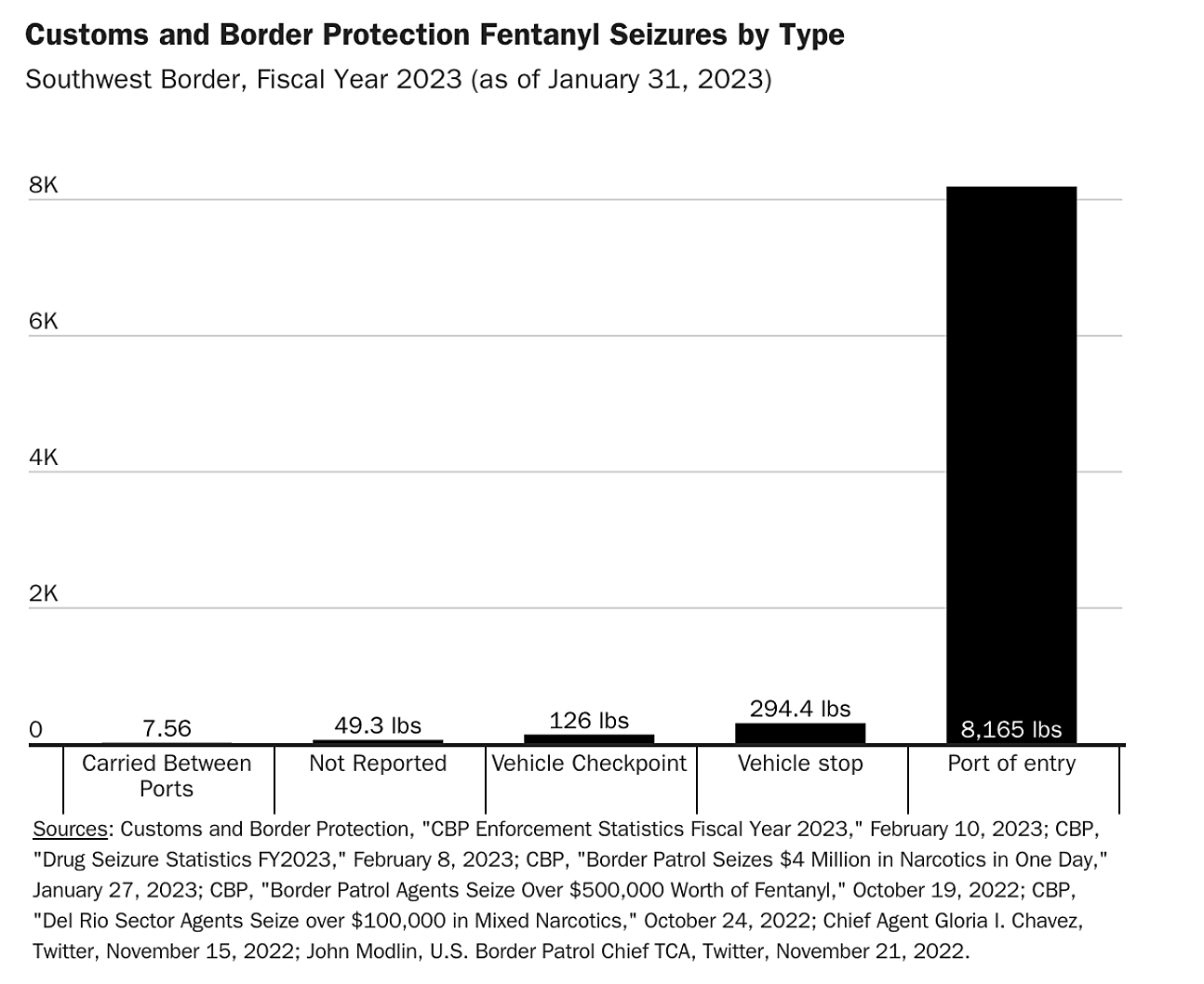
Although CBP’s data obviously does not include the fentanyl that escapes their detection—both at ports and between them—CBP’s seizures provide a sample to estimate the rate at which people who evade detection are carrying fentanyl. Assuming that all fentanyl without a reported seizure location was carried over, Border Patrol still would have seized just one pound of fentanyl outside of vehicle searches for every 13,700 people that it has arrested crossing the border in FY 2023.
CBP has not estimated the quantity of fentanyl successfully smuggled through ports of entry, but for several years, it has calculated the probability of seizure for cocaine at ports of entry. In 2020, it estimated that CBP seized just 2 percent of the cocaine entering the country at ports.42 Given its potency, significant amounts of fentanyl are even easier to conceal than cocaine. By contrast, CBP estimates that it interdicts a majority of the people crossing the border illegally.43 Thus, it is more than 90 percent easier to enter the country legally with hard drugs than cross the border illegally with them.
The story that Border Patrol seizes less fentanyl because the agency cannot interdict drug smugglers is wrong. Rather, it seizes so much less because the economics dictate the location of fentanyl smuggling. By contrast, because marijuana is so bulky, pungent, and generally easier to detect, traffickers usually bring it around ports of entry.44 The graph below shows how Border Patrol seizes far more marijuana smuggled between ports of entry than CBP at ports of entry, while the reverse is true for hard drugs that are easier to conceal.45 The drug type determines the location of smuggling, which determines the location of seizures, not Border Patrol’s inability to stop smugglers.
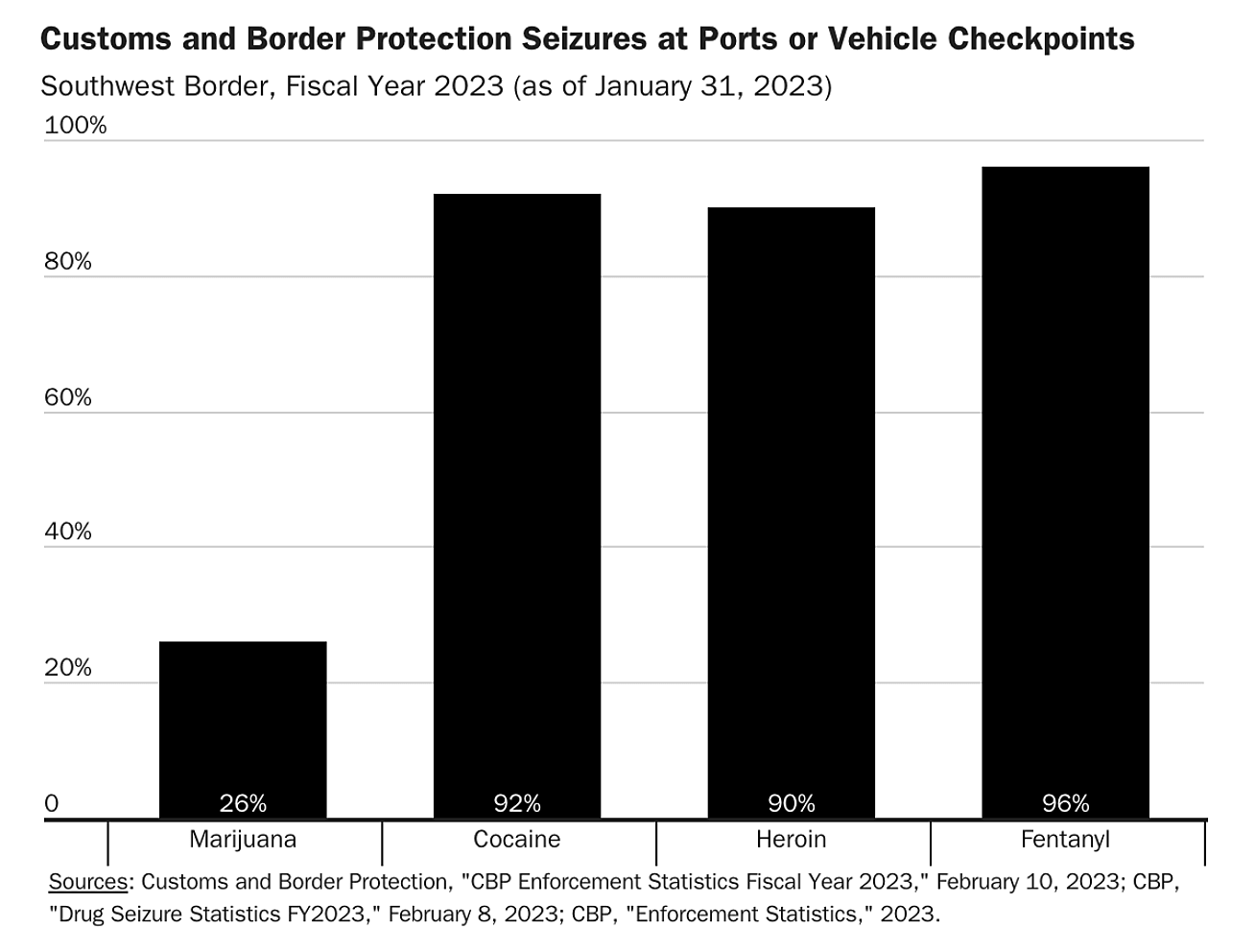
Border Patrol also does not seize any more fentanyl when arrests fall. It is noteworthy that despite a 42 percent drop in arrests in January, Border Patrol seized almost no fentanyl (just 4 pounds) not at vehicle stops or checkpoints, the same amount as the prior month.46
Qualitative assessments based on law enforcement intelligence also indicate that trafficking organizations understand that hard drugs are more easily smuggled through ports. The Drug Enforcement Administration’s (DEA) National Drug Threat Assessment 2021 has said drug traffickers “exploit major highway routes for transportation and the most common method employed involves smuggling illicit drugs through U.S. POEs in passenger vehicles with concealed compartments or commingled with legitimate goods on tractor-trailers.”47 DEA testified that its investigations have found that “the vast majority of fentanyl is coming in the ports of entry.”48 CBP and other agencies have made similar assessments.49 It is exactly because these ports of entry are both scarce and incredibly valuable that cartels war for control over them.50
The reasons for the ease at which drugs enter through ports is multifaceted. Only 6 percent of commercial trucks and 1 percent of passenger vehicles are scanned for any drugs.51 CBP reports of drug interdiction arrests indicate that it is most often the driver’s behavior that tips off agents to conduct a search, meaning that interdiction is dependent on a factor almost entirely outside of the agency’s control.52 The motivation for traffickers to innovate to evade detection is much stronger than the motivation to innovate to detect drugs crossing, which results in increasingly sophisticated smuggling techniques that quickly defeat interdiction efforts.
Even when a drug is easier to detect, the massive difference between the cost of production abroad and its value in the United States means that trafficking organizations can respond to greater interdiction simply by increasing production and smuggling more. From 2003 to 2009, for instance, Border Patrol more than doubled its staffing and built hundreds of miles of fences. As a result, Border Patrol marijuana seizures doubled, but cartels simply smuggled more to compensate, and the effort made no difference to the availability of Mexican marijuana in the United States.53 In fact, the effort backfired. During Border Patrol’s hiring surge, the potency of marijuana increased by 37 percent.54
Fentanyl trafficking itself developed as a border-evasion measure to supply the market for heroin and other opioids. It had initially little natural demand because the fentanyl experience is so fundamentally different from heroin.55 But fentanyl has 50 times the potency of heroin, which means that the same weight can supply 50 times as many consumers, creating a massive economic incentive for smugglers to prefer it to heroin.
Despite fentanyl’s built-in economic advantage, it took the massive restriction in imports and travel during the pandemic—particularly the U.S. policy of limiting travel with Mexico—to force U.S.-Mexico border traffickers to shift from heroin to fentanyl. Within two months of the pandemic, fentanyl seizures overtook heroin by weight, and by the time the restrictions were lifted, fentanyl was accounting for over 90 percent of the seizures.
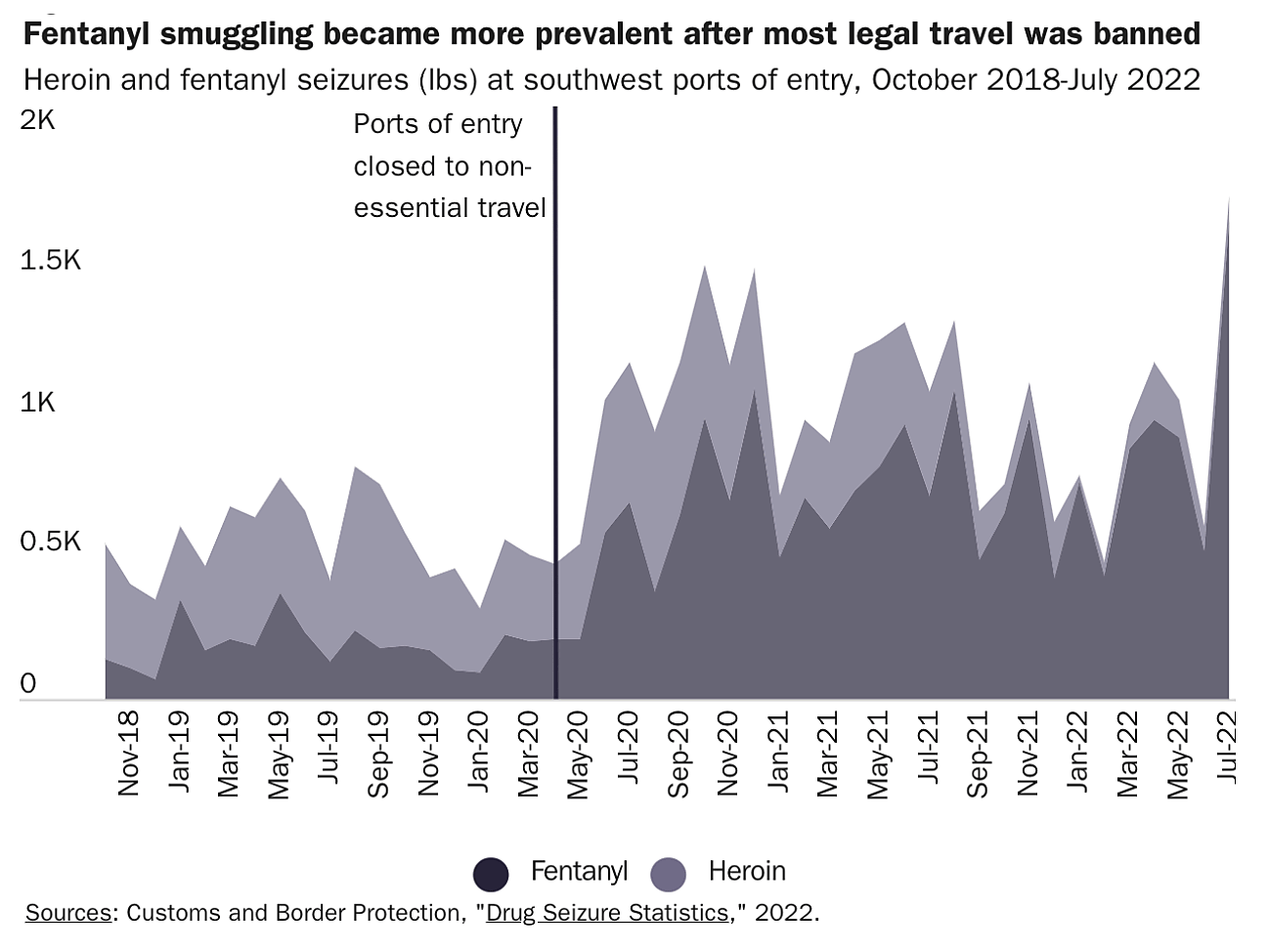
Tragically the shift toward fentanyl and away from heroin caused a spike in fentanyl deaths. From 2019 to 2021, fentanyl deaths nearly doubled as trade and travel were restricted with Mexico. Unfortunately, additional efforts to restrict the trade in fentanyl will likewise backfire. There are already synthetic opioids many times more powerful than fentanyl that cartels could switch toward if fentanyl trafficking becomes more difficult. For instance, the Tennessee Department of Health reported a fourfold increase in deaths in 2021 from Nitazenes—synthetic opioids 10 to 20 times more potent than fentanyl.56
This process of enforcement increasing the potency of prohibited items is called the “Iron Law of Prohibition.” It occurred under Alcohol Prohibition when liquor dominated wine and beer, and it has repeatedly played out under drug prohibition: crack cocaine as a substitute for powdered cocaine, heroin as a substitute for prescription drugs, and fentanyl as a substitute for heroin. To stop drug deaths, policymakers must focus on demand, not supply.
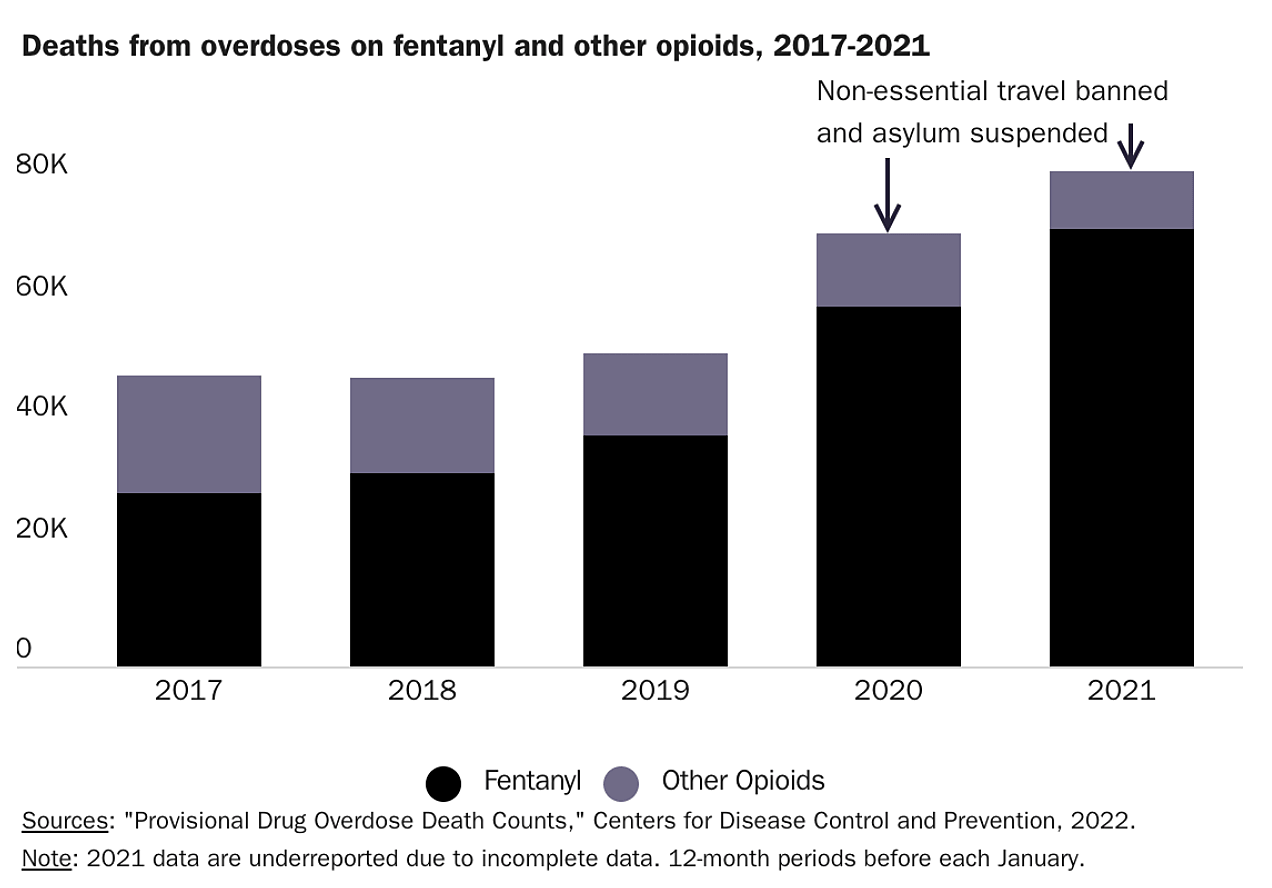
The drug war and restrictive border policies have failed people with addictions and their families. Government should stop criminalizing drug users, which pushes them away from services that could help them, and Congress should legalize overdose prevention sites, places where people can intervene to reverse an overdose.57 States should allow users to protect themselves against overdoses by legalizing fentanyl test strips, which most states criminalize as “drug paraphernalia.”58 Physicians should be empowered to treat addiction by weaning addicts off these potent drugs and by issuing at-home prescriptions for methadone.59 These are all ideas that have worked in other countries to reduce deaths.60
Restricting immigration also has another side benefit for drug cartels: they can charge immigrants to cross illegally into the United States.61 Two migrants in Tijuana were stoned to death and another shot for failing to pay a fee this week.62 Migrant smuggling has now become a $13 billion industry.63 The United States could immediately remove this profit from the cartels by creating legal ways to enter the country.
Restrictive Border Policies Create Chaos
Because nearly all potential immigrants have no legal pathway to enter the United States, it is no surprise that many choose to cross illegally. For many countries, the only ticket out poverty is a ticket to the United States. For instance, 92.7 percent of people born in Haiti who live above the developed world poverty line live in the United States.64 Immigration reduces poverty because U.S. free institutions and technology allow immigrants to be far more productive here than in their home countries. If America is the best hope to live a free and dignified life, immigration will continue regardless of the laws on the books. Congress should focus on channeling immigrants toward lawful ways to enter rather than swim upstream against the law of supply and demand.
Restrictive border policies have only created more problems. Since at least the Border Patrol’s 1994 Strategic Plan, Border Patrol has made an intentional effort to drive cross-border traffic out of urban areas and into more rural areas where it is more hazardous to cross.65 Following this shift, the Government Accountability Office (GAO) found that “the strategy has resulted in an increase in deaths from exposure to either heat or cold.”66 As a result of this deliberate and ongoing strategy, more migrants are crossing the border in perilous conditions and straining in rural hospitals, as the Committee will hear about today.
The border walls have greatly exacerbated the risks. The Mexican government has found that border walls or fences were responsible for 80 percent of injuries by border-crossing Mexicans returned by the United States last year.67 In 2021, trauma surgeons in California found themselves overwhelmed with the hundreds of wall-related injuries, which increased by 460 percent following the wall construction.68
The last administration constructed a wall so high that rather than merely increasing the risk of capture for immigrants, it significantly increased the risk of death. The 30-foot height was reportedly based on field tests to determine the height at which the average person would become disoriented and stop climbing.69 But even lower fences are a danger. A pregnant woman died from falling from an 18-foot fence in 2020.70 A number of those injured have been in Yuma, Arizona, including two men who died in 2020 and 2021.71 In 2018, two teenage girls also suffered life-threatening injuries after falling from the Yuma fence.72
At least 28 deaths have occurred from fence falls from 2019 to 2022.73 But by pushing immigrants out into even more remote areas, the wall can also indirectly cause more deaths. A total of 853 immigrants died crossing the border in 2022—the most on record.74 This topped the prior record of 560 deaths in 2021.75 About 60 deaths in 2022 were in Yuma County, Arizona.76 In 2021, Border Patrol reported that it rescued 12,578 people in serious physical distress, triple the number in 2018.77 Since 1990, when the first fences were built in San Diego, Border Patrol has recorded almost 11,000 deaths,78 and independent auditing of its count by the Government Accountability Office has found that Border Patrol systematically undercounts migrants deaths, excluding—for instance—half the migrant deaths in Tucson, Arizona, which are tracked by local authorities.79
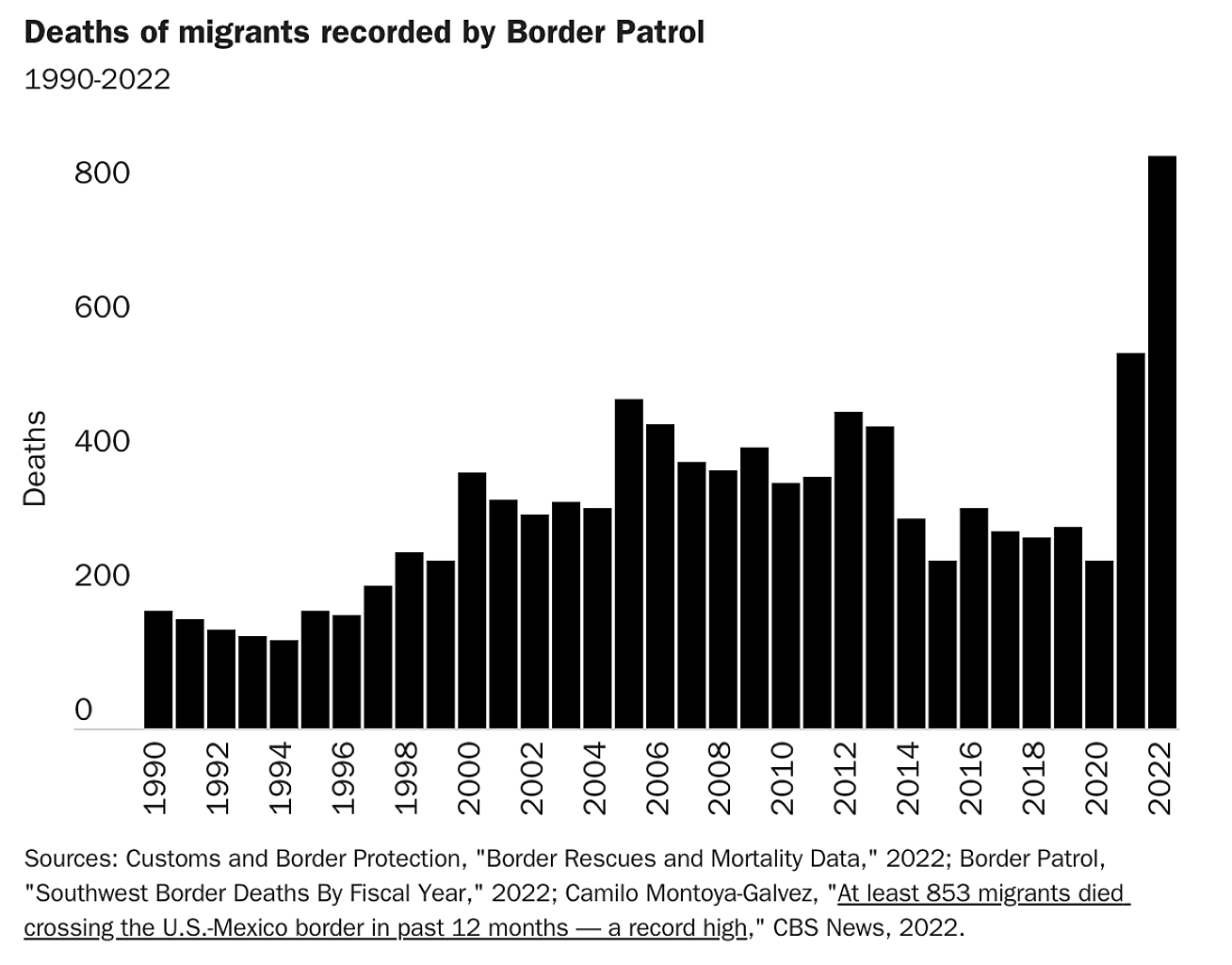
The inability to board lawful transportation options to the U.S. border creates treacherous conditions for travelers. The combination of homelessness and governmental indifference toward crimes against migrants in Mexico has created the ideal environment for all manner of predation. Abductions of migrants number in the tens of thousands annually, according to Mexico’s National Human Rights Commission.80 Rapes of migrant women in Mexico are common, underreported, and rarely investigated.81 All these factors mean that many migrants cross in need of urgent medical attention, and Border Patrol policies force them to cross in areas with the fewest resources.
It is not just taxing for local hospitals. The Border Patrol’s 1994 Strategic Plan treats the lack of transportation infrastructure in rural areas as a reason to push traffic there.82 But when Border Patrol releases asylum seekers in small towns along the border, it can take days for them to get a bus to their final destinations. The lack of buses led to a backup of migrants with nowhere to live and forced Yuma’s mayor to declare a state of emergency.83 If immigrants could enter legally, they could line up transportation in advance, travel directly to their final destinations, and fix this issue.
The mere fact that a person entered illegally means that Border Patrol must take them into custody for processing. When capacity is reached, they end up unexpectedly releasing migrants onto the streets—often at night with no warning and no transportation lined up.84 These types of releases have occurred under every administration.85 Sometimes pregnant women or nursing mothers are forced to sleep on the streets.86 These are all avoidable problems if legal migration pathways were available.
Another problem is of greater importance to localities: the inability for people to work legally after their release from Border Patrol custody.87 Although asylum seekers are eligible to receive employment authorization documents six months after applying for asylum, this process can often take much longer, given the time it takes to prepare an asylum application and the time to process the employment authorization request.88 The mayor of New York City has labeled this one of the most urgent immigration issues facing his city.89 Research has found that banning asylum seekers from working has negative employment effects long after the ban is lifted.90 Lacking the right to work, asylum seekers must often either work illegally or depend on charity or city services.
Restricting Asylum Is Not a Solution
Title 42 and restrictions on applying for asylum also create additional health hazards for migrants. Returning migrants to Mexico has created a flow of migrants more in need of medical attention because the policy alerts criminals in Mexico to the fact that they may have U.S. connections. When they recross the border, these victims often need health care. Human Rights First has tracked over 13,000 publicly reported incidents of murder, torture, kidnapping, rape, and other violent attacks on migrants and asylum seekers returned to Mexico in the last 2 years alone.91
Migrants who seek asylum generally turn themselves into Border Patrol, avoiding more dangerous crossings in remote areas and making them easier to process. Evasion leads to more deaths and injuries in remote areas. Also, smugglers (usually U.S. citizens) sometimes drive recklessly to avoid the Border Patrol and risk the lives of the passengers, and bystanders, leading to more hospital trips.92 At least 93 people have died during Border Patrol pursuits since 2010.93
The number of chases doubled from 150 in 2021 to 300 in 2022, and the number of deaths during pursuits increased from 2 in 2019 to 14 in 2021 and 22 in 2022.94 From 2015 to 2018, there were about 11 injuries for every death resulting from Border Patrol chases, implying that hundreds of people have been injured across the border in the last two year in this way.95 Smugglers also abandon migrants in deserts where they may need to be airlifted to hospitals.96
Anti-asylum policies are not just bad for the safety of immigrants and residents—they are also bad for security. Since Border Patrol initiated the Title 42 policy that banned asylum for most crossers, evasion almost immediately exploded. The number of gotaways—detected successful crossings—grew fourfold from calendar year 2019 to 2022. The country has seen more crossings, more arrests, more illicit entries, and less security under the anti-asylum policy of the last three years.

A major reason for this change is that when someone is returned to Mexico—and not processed for asylum or returned to their home country—they have little choice but to attempt to reenter illegally. The recidivism or re-encounter rate started to spike under the Remain in Mexico policy, which sent people back to wait for hearings. That policy had a lifetime re-encounter rate of 33 percent (as of June 2021).97 Under Title 42, the situation deteriorated further with a 1‑year re-encounter rate exceeding 50 percent in 2021 98
Nor is this due to insufficient enforcement of Title 42. In fact, Title 42 has encouraged more crossings. Encounters of the demographic group most targeted under Title 42—single adults from the Northern Triangle and Mexico—have increased fourfold, even though they have been expelled more than 90 percent of the time.
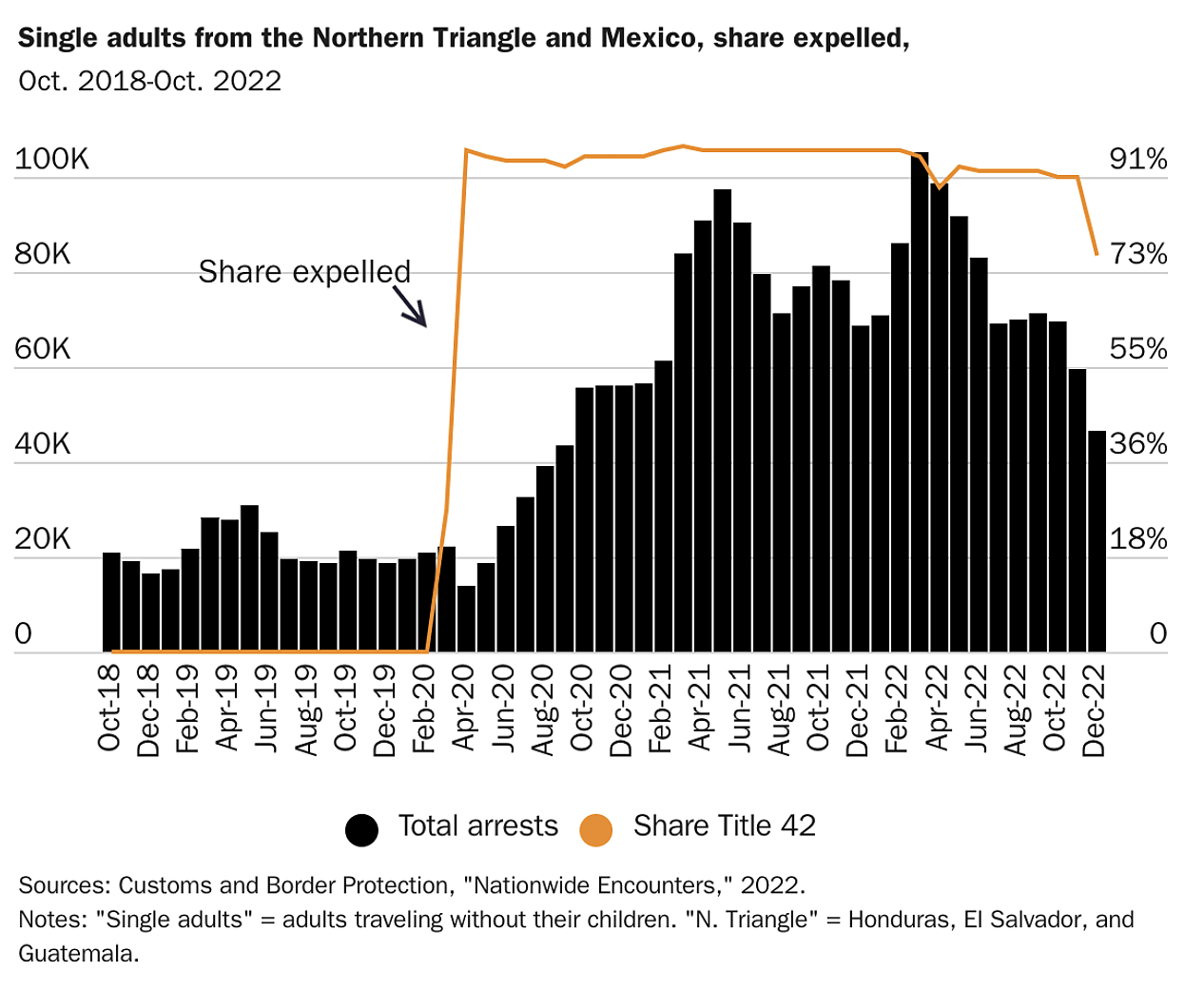
Although Border Patrol certainly does encounter some genuine threats, asylum provides agents with a mechanism to sort out those with nothing to hide.99 It would be better if asylum seekers were processed at ports of entry where they could enter legally, but it is important to understand the full context for the Border Patrol resources available relative to the flows. Even with the massive increase in arrests under Title 42, each Border Patrol agent averaged fewer than 1 arrest every three days in 2022.100 As the graph below shows, the extremely low rates of arrests per Border Patrol agent from 2009 to 2020 were a departure from the norm for the period since 1965.
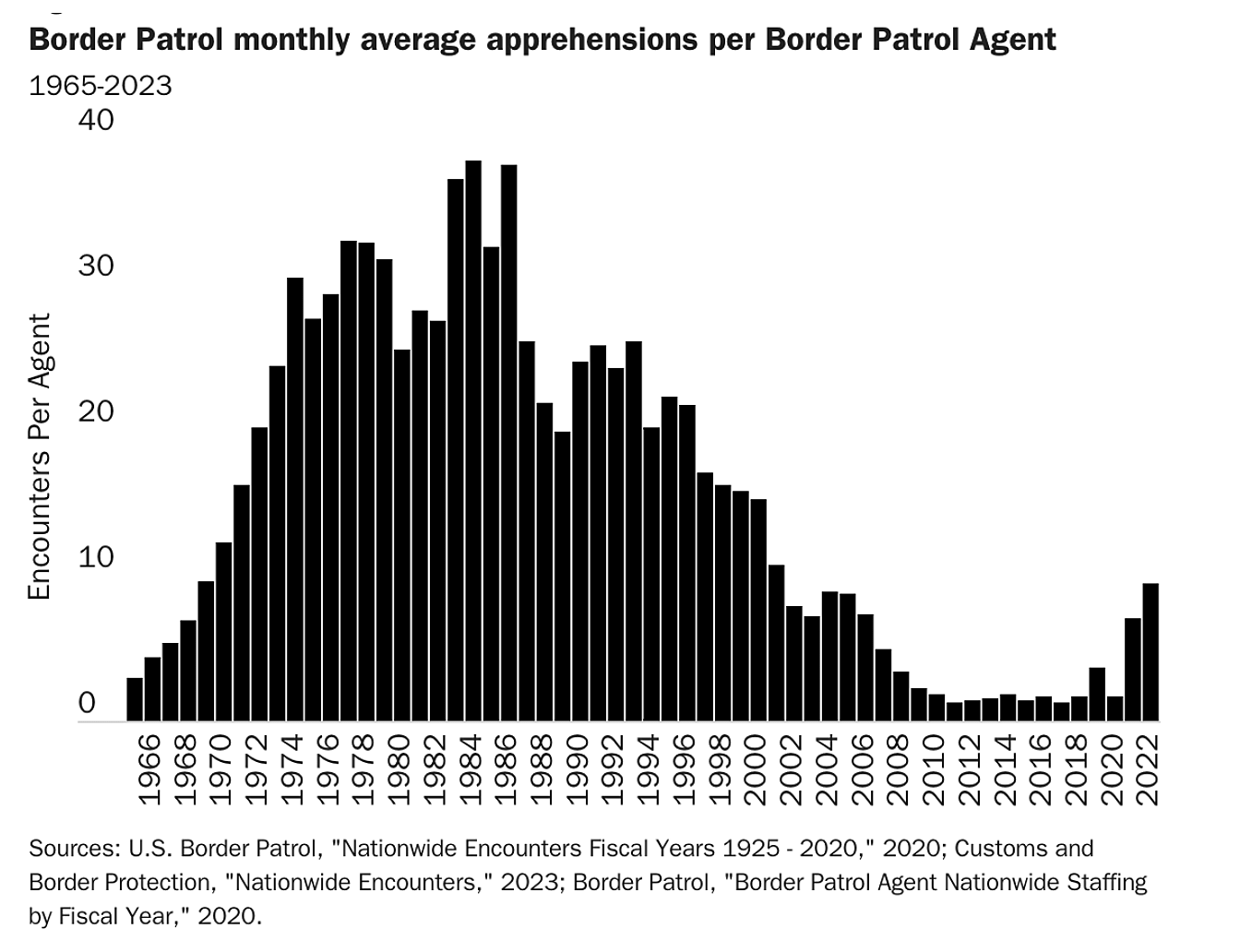
Legal pathways including asylum would allow Border Patrol to focus on true threats to Americans, but these threats should not be exaggerated. For instance, CBP has reported a dramatic increase in encounters whose information appears on the Terrorism Screening Dataset.101 There were 98 such encounters in 2022. According to nonpublic data obtained by the media, 93 percent of the terrorist database hits were for Colombians.102 These people could be former FARC revolutionaries, but the evidentiary bar for inclusion in this dataset is so low that it is impossible to conclude much from this statistic. CBP even says that the data include people supposedly associated with people supposedly associated with terrorist groups or activities.103 As importantly, matches can occur based on biographic information like a person’s name and date of birth, leading to numerous false positives. One false positive was reported in the media just this month.104
Unlike Border Patrol, CBP ports of entry officers encounter thousands of people on the terrorist watch list every year.105 It is telling that none of these encounters have produced any convictions for a plot to attack the United States.106 In fact, over the last four decades, not a single American has died in a terrorist attack carried out by a person who entered the country illegally mainly because no such attack has ever occurred.107 The threat of terrorism is not a reason to eliminate asylum, and the entities that needs more resources to deal with terror suspects is ports of entry, not Border Patrol stations.
Illegal Immigration Is a Policy Choice
Creating legal pathways for immigrants to live and work in the United States can restore Border Patrol’s mission to one of national security, not managing peaceful migration. Legal pathways can dramatically reduce illegal immigration and related problems. Here are five examples:
- The Bracero guest worker program from 1954 to 1965 was expanded to direct Mexican farm workers to enter the United States legally. The program reduced border apprehensions by more than the number of Braceros admitted legally because workers were willing to wait to come legally.108

- Wet Foot, Dry Foot as applied at U.S.-Mexico land ports of entry from 1995 to 2017 allowed tens of thousands of Cubans to enter the country legally with a status known as humanitarian parole, and the U.S.-Mexico border had almost no issue with Cubans crossing the border illegally. Remain-in-Mexico and Title 42 ended this policy, creasing a massive illegal immigration problem by Cubans.109
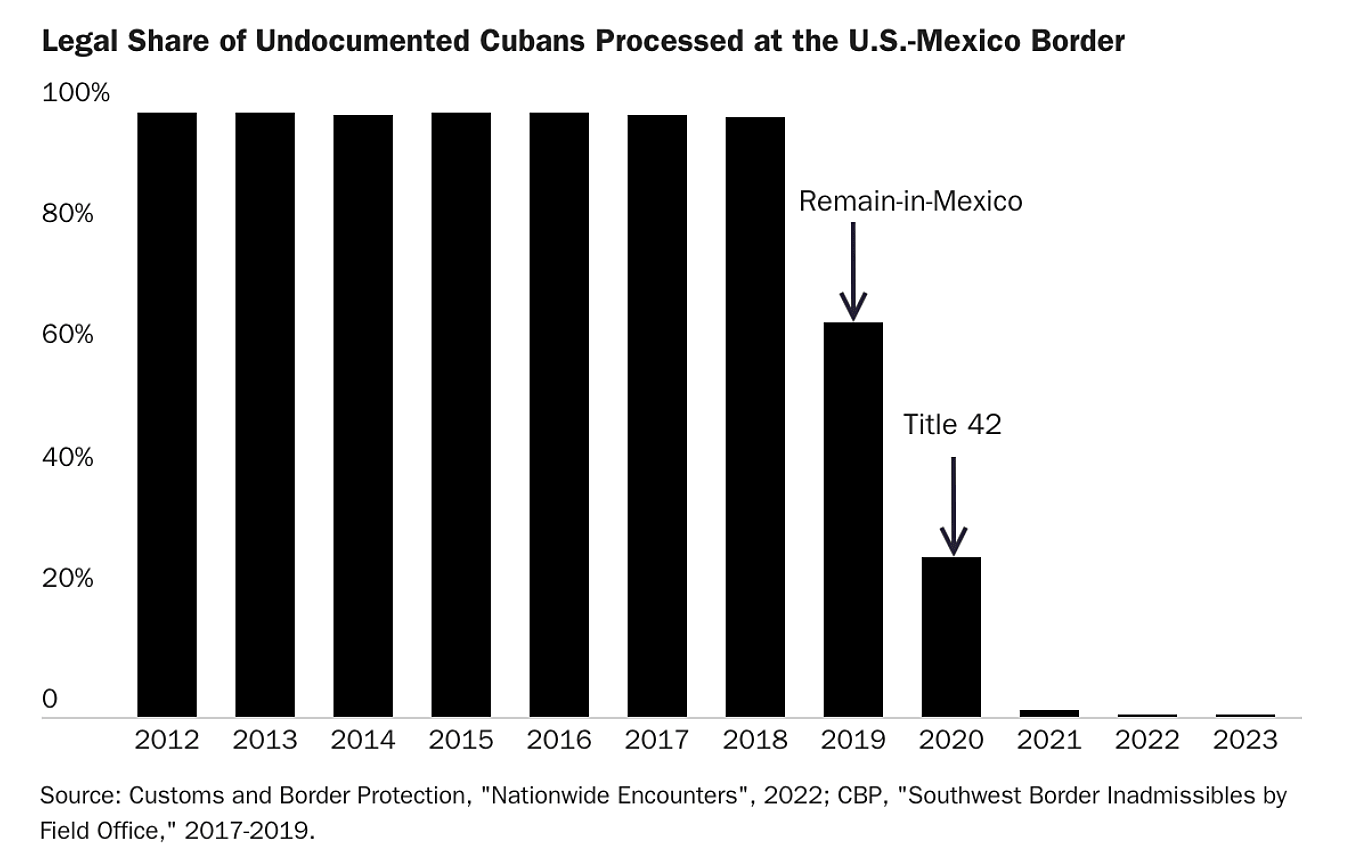
- Following the Earthquake in 2010, the United States stopped deporting Haitians, and U.S.-Mexico land ports of entry stopped detaining Haitians requesting asylum and let them enter legally into the United States. As a result, from 2010 to 2016, nearly all Haitians entered the country legally. In late-2016, CBP reversed the non-detention and non-removal policy, and in 2018, it covertly capped asylum requests at ports of entry, causing more to cross illegally. Title 42 ended all asylum at ports of entry, and nearly all Haitians entered illegally, culminating in the disaster in Del Rio when Haitians were trapped in a detention camp without food for weeks.110 In early 2022, CBP began processing Title 42 exception requests at ports of entry, and Haitians returned to entering the country legally as they had before.

- Following the Russian invasion of Ukraine, Ukrainians began to show up at the U.S.-Mexico border by the tens of thousands. CBP granted them exceptions to the Title 42 policy and let them into the country legally. In May, it improved on this policy when it created the Uniting for Ukraine parole program, which has already allowed over 117,000 Ukrainians to fly directly to the United States if they lined up a U.S. financial sponsor.111 This policy reduced the flow of Ukrainians to the U.S.-Mexico border by over 90 percent.
- The administration recently created new parole programs modeled on the Uniting for Ukraine program for Venezuelans (in October 2022) and Nicaraguans, Cubans, and Haitians in January 2022. These programs have also diverted a substantial number of immigrants away from illegal immigration. Reuters reported in mid-January that Cubans “previously flocking to Nicaragua to head overland had largely changed strategies, many opting instead to try their luck with the parole program.”112 Illegal entries from these four countries fell by 86 percent in a single month.113
In January 2023, CBP also rolled out its CBP One phone app that allows people to submit requests for an exception to the Title 42 ban on asylum at ports of entry. The app has had a temporary effect on the number of illegal crossings from countries other than those with the parole sponsorship program, but CBP has capped the number of Title 42 exceptions at such a low number that asylum seekers are already realizing that the app may not be a viable legal path for them.114 CBP should open more asylum appointments at ports of entry to reduce violations of the law.
Illegal immigration is a choice that policymakers select when they restrict lawful ways to enter the United States. Congress should work with the administration to expand on these successful initiatives to eliminate illegal immigration and help address the needs of communities across this country.

This work is licensed under a Creative Commons Attribution-NonCommercial-ShareAlike 4.0 International License.
